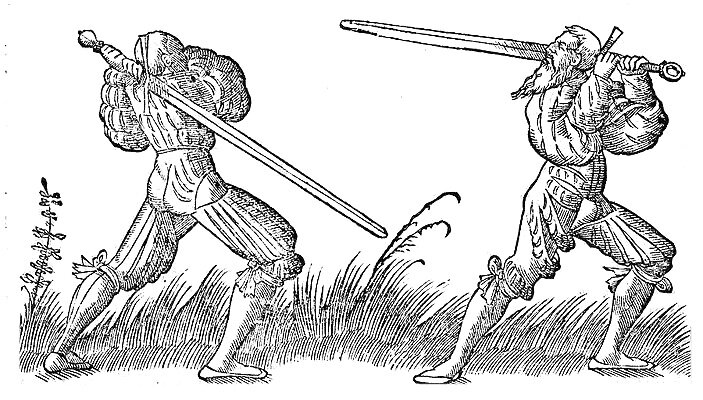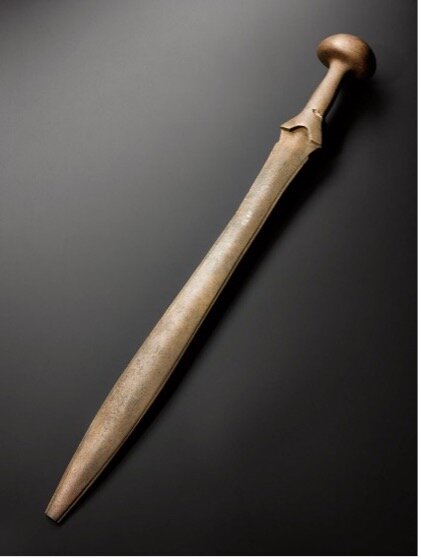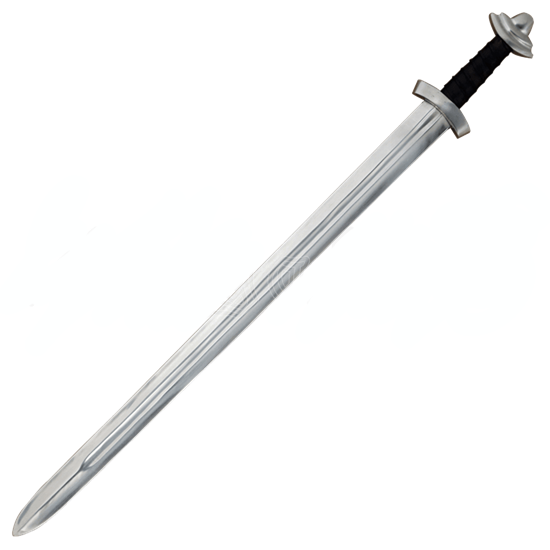SWORDS and DAGGERS
Bronze Dagger
Period: 2000 BC
Length: 30 cm / 12”
Daggers developed from simple sticks and sharpened flints into an easily carried weapon and hunting tool.
The dagger design is similar to a Halberd with a pointed and tanged blade but could incorporate a location and fixing points for a handle.
The use of precious metal fittings such as local Scottish gold would emphasise the status of the owner.
The dagger is constructed from a single blade cast from bronze. Carved wooden handles are attached to either side with bronze rivets. The decoration here would be from a beaten metal such as gold and would indicate a ceremonial dagger or wealthy ownership.
Celtic Bronze sword
Period: 750 BC
Length: 70 cm / 28”
A number of areas of Scotland became centres for production of swords in the late Bronze Age.
Longer slashing swords became popular among cultures such as the Celts.
They could be used on foot or from horseback, and were prestigious weapons.
Examples of this type of sword can be found throughout areas of early Celtic settlement.
The sword is constructed from cast bronze with a hammered edge providing a sharp and hardened cutting blade. The leaf shaped blade incorporates a handle plate with rivet holes. Bronze rivets are used to attach a shaped handle of wood or bone. The shape of the blade provides a sharp point for piercing thrusts and a sharp curved edge for slicing at opponents.
Pict Iron sword
Period: 500 AD
Length: 60 cm / 24”
Few fragments survive from Pictish weapons but it is possible to prepare reconstructions from Pictish stone inscriptions.
Many illustrations show a distinctive curved pommel above the blade. Though some artefacts suggest intricate ornamentation and silverwork was also used. The blades are considered to be wide and designed for slashing and stabbing. Illustrations indicate that the point may have been rounded rather than worked to a point.
The sword blade shown is a cast iron wide blade with ground and sharpened edges. The iron blade is cast with an integral tang onto which is fitted a bronze pommel and quillion with an ivory handle.
Roman Sword
Period: 200 AD
Length: 40 cm / 16”
The Roman influence in Scotland was limited, but the building of Hadrians Wall established a formal occupation in Southern Scotland. Further advances were made to the north and Roman artefacts have been found throughout the country.
Items such as Roman Swords were high quality and looted weapons were highly prized.
The Sword carried by the Roman troops was proven over centuries of campaigns and well suited to their style of close quarter fighting. The short two edged blade is waisted with a sharp point. The hilt has bronze fittings and a turned ivory grip.
Viking sword
Period: 900 AD
Length: 70 cm / 28”
Viking swords were generally double edged.
Examples can be found throughout the Scottish islands where Viking occupation was widespread.
Many of the examples found have been part of boat burials where the owner is buried with his weapons and riches.
The Viking sword blade is iron and of heavy construction with a central groove down the centre of the blade.
The handle comprises a curved iron quillion with a wooden handle supported by bronze fittings. The bronze pommel represents a typical norse symbol
13th Century Sword
Period: 1250 AD
Length: 1 metre / 41”
The design of swords evolved through the Dark to Middle ages. As the Celtic and Pictish influences diminished, Scottish weapons makers adopted similar practices to the English and Europeans.
Sword blades were made of high-quality iron and steel and the sword was widely adopted as the personal weapon of both rich and poor.
This example from the 13th century shows that quillions were becoming longer, though the hilt is secured with a wheel pommel which had been popular for centuries. The tapered quillion is well balanced as well as elegant and the diamond cross section of the blade provided a better balance. This simple design has a tapered handle wrapped in braided cord.
14th Century Sword
Period: 1380 AD
Length: 1.1 metres / 43”
The balance of the sword became important as sword skill formed an essential part of the education of Scottish chieftains and gentry.
Blades became longer and lighter, with the blade being balanced by an extended hilt with a weighted pommel.
A raised fuller was incorporated into the length of the blade to provide additional stiffening.
The quillions of this 14th century sword are extended, curved and have simple ornamentation. Though Sword construction was often undertaken in Scotland, the polished and tapered blade was probably imported from France or Germany. The turned walnut grip has been extended and the weight of the square tapered pommel is used to assist in the balance of the sword.
Claymore – Claidheamh da laimh
Period: 1550 AD
Length: 1.2 metres / 47”
The famous two-handed sword, the Claymore, (claidheamohmor - great sword) first made its appearance around 1490 and was developed by the Hebridean Gallowglass warriors.
This early Highland version measured between 53 and 60 inches overall.
The two-handed claymore, became popular during the 16th and 17th centuries.
These large weapons were impressive but heavy and unwieldy to use in battle. Whilst examples exist which have been used in battle, it is likely that the claymore also developed as a ceremonial weapon used by chieftains.
Illustrated is a double handed Iberia Highland Claymore with a blade of about 1 m length. The drooping quillions, quatrefoils and pommel are typical of the Highland Claymore and are made of steel with a braided grip.
Basket Hilted Broadsword
Period: 1745 AD
Length: 1.5 mretres / 59”
The weapon most generally associated with the Highlanders and Jacobites is the basket-hilted broadsword, also referred to as a claymore or claidheamh mor.
The weapon first appeared in the 16th century and the cage basket which provides protection for the hand is a development of the simpler quillioned hilt.
The sword is fitted with a straight double edged blade.
Most of the high quality steel blades originated in Germany and being expensive would probably be recycled several times and fitted with new hilts.
The configuration of the basket adopts the features found in most surviving examples.
The main bars and knuckle guards protect the hand and extending rear and forward guards provide extra protection.
The broadsword design has a simple construction of iron with downturned quillions and curved shell covers protecting the hands. The wooden handle is leather bound and the square tapered pommel of iron secures the assembly with a threaded connection to the sword tang.
Biodag - Dirk
Period: 1745 AD
Length: Biodag
The larger and more expensive arms such as sword and musket would probably be issued to highlanders who were enlisted or conscripted into the army. A self respecting highlander would however carry his own dirk. The dirk performed many functions such as eating, in addition to being used for hand to hand combat.
The blade of the dirk is 20 inches long, single edged and has a fuller on the opposite edge to provide additional stiffness.
The hilt and pommel are of solid cast brass with a grip from carved ebony. The tang of the blade is secured by a tang nut.
Whinger
Length overall 49 cm / 19¼”
blade 38 cm / 14¾”
The Whinger was a thrusting and stabbing type of dagger similar to the Poniard dagger which was popular in the south and east of Scotland in the 17th Century.
It appears to be a dressy alternative to the dirk. Made in North-East Scotland, whingers were carried by the more "civilized", English-speaking Lowland Scots.
Their long thin dagger with a triangular single edged blade and a flat surface made them a very efficient weapon.
The blade was usually fitted with wooden grips and iron mounts and held in a scabbard that often had a knife and fork attached - making it a very utilitarian weapon.
Poignard
Similar in design to a parrying dagger, a poniard is a long, lightweight thrusting knife with a continuously tapering, acutely pointed blade and cross guard, historically carried by the upper class, noblemen, or the knighthood.
The Fairbairn–Sykes fighting knife may be thought of as a modern version of the poignard.



















